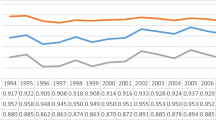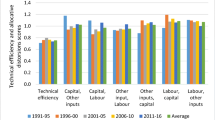Abstract
I examine inefficiencies in Japanese water utility companies. Efficiency in this context is defined as a firm’s capacity to maximize output given a fixed level of inputs. The findings suggest that the average operation rate, customer density and size variables are associated with lower levels of inefficiency (or higher levels of efficiency), while water purification (a conditioning variable capturing low initial water quality), subsidies and outsourcing are associated with higher levels of inefficiency. Since inefficiency exists, there is an opportunity to improve Japanese water utilities by working on emulating “best practice” firms whenever possible and by providing a regulatory framework that can set appropriate incentive schemes to do so.

Similar content being viewed by others
Notes
The focus of the Yane and Berg (forthcoming 2013) paper is on the robustness of efficiency score rankings across different specifications for SFA models. The present paper focuses on policy implications of inefficiency effects. The Yane and Berg paper does not explore specific policy implications for the Japanese water utility sector because it focuses on the methods used and robustness when different distributional assumptions are utilized in correcting for heteroscedasticity. Yane and Berg narrowly focus on error terms associated with doubly heteroscedastic SFA.
If all firms were able to operate at the frontier (i.e., be fully efficient), SFA would not be required.
These models are estimated using the maximum likelihood method. The “maximum likelihood estimate of an unknown parameter is defined to be the value of the parameter that maximizes the probability (or likelihood) of randomly drawing a particular sample of observations” (Coelli et al. 2005). For a well-behaved linear function, maximization usually involves taking first derivatives with respect to unknown parameters and setting them equal to zero. However, because these specific problems cannot be solved analytically (given the existing non-linearities and the large number of parameters) iterative optimization procedures are used. Essentially, a computer program selects starting values for these unknown parameters and updates them until the values that maximize the log likelihood function are obtained Coelli et al. (2005). Unfortunately, sometimes iterative optimization procedures do not converge to a maximum at all. In other words, the computer program is unable to find the values that maximize the log likelihood function, which is what happened with the translog specification for this paper using the selected distributional assumptions.
The \(\mathrm{{z}}_\mathrm{it}\)’s are referred to as the “inefficiency effects model variables” throughout this paper.
This paper uses the same output and inputs as Yane and Berg (forthcoming, 2013). For input observations that have original values of zero, I adopt the standard practice of calculating log values by adding one to these original values.
Estimated staff from outsourcing is calculated following Yane and Berg (forthcoming, 2013). Virtual staff is calculated by dividing outsourcing expenditures by payment per employee in each prefecture.
Total intake water capacity \(=\) self-produced capacity \(+\) purchased water capacity.
Where gamma is defined as \(\gamma ={\sigma _{u}^{2}}/{\sigma ^{2}}\) and varies from 0 to 1. A gamma value of 0 would indicate that OLS provides consistent estimates.
Perard also discusses why introducing competition for the market doesn’t solve this problem. Readers are referred to Perard (2009) for more information on this topic and for a complete summary of the results of privatization in different countries.
Even though anecdotal evidence suggests that the outsourcing decision is due to an aging workforce there is a possibility that inefficient firms may be precisely the ones turning to outsourcing, so causation is reversed. Therefore, it is conceivable that this result could stem from endogeneity, where firms that experience relatively high costs turn to outsourcing. More research is needed to resolve the issue of causation.
A listing of the regions is available upon request.
Certain characteristics influencing efficiency are clearly outside of managerial control. Customer density, for instance, depends on where customers decide to live. It would be illogical to suggest improvements in efficiency based on increases in customer density to a manager, particularly in rural towns facing emigration towards the big cities.
References
Aida, K., Cooper, W. W., Pastor, J. T., & Sueyoshi, T. (1998). Evaluating water supply services in Japan with RAM: A range-adjusted measure of inefficiency. Omega, 26(2), 207–232.
Aigner, D., Knox Lovell, C. A., & Schmidt, P. (1977). Formulation and estimation of stochastic frontier production function models. Journal of Econometrics, 6(1), 21–37.
Artana, D., Navajas, F., & Urbiztondo, S. (1999). Governance and regulation: A tale of two concessions in Argentina. In W. D. Savedoff & P. T. Spiller (Eds.), Spilled water: Institutional commitment in the provision of water services. Washington, DC: Inter-American Development Bank.
Battese, G. E., & Coelli, T. J. (1992). Frontier production functions, technical efficiency and panel data: with application to paddy farmers in India. Journal of Productivity Analysis, 3(1–2), 153–169.
Battese, G. E., & Coelli, T. J. (1995). A model for technical inefficiency effects in a stochastic frontier production function for panel data. Empirical Economics, 20(2), 325–332.
Baumert, J., & Bloodgood, L. (2004). Private sector participation in the water and wastewater services industry. U.S. International Trade Commission Office of Industries Working Paper.
Berg, S. (2010). Water utility benchmarking: Measurement, methodologies, and performance incentives. London: International Water Association Publishing.
Berger, A. N., & Humphrey, D. B. (1997). Efficiency of financial institutions: International survey and directions for future research. European Journal of Operational Research, 98(2), 175–212.
Coelli, T.J. (1996). A guide to FRONTIER version 4.1: A computer program for stochastic frontier production and cost function estimation. University of New England CEPA Working Paper.
Coelli, T. J., Prasada Rao, D. S., O’Donnell, C. J., & Battese, G. E. (2005). An introduction to efficiency and productivity analysis. New York, NY: Springer.
Corton, M. L. (2011). Sector fragmentation and aggregation of service provision in the water industry. Journal of Productivity Analysis, 35(2), 159–169.
Data Monitor. (2010). Industry profile: Water utilities in Japan. Datamonitor Business Information Center.
Estache, A., & Kouassi, E. (2002). Sector organization, governance, and the inefficiency of African water utilities. World Bank Policy Research Working Paper.
Groom, E., Halpern, J., & Ehrhardt, D. (2006). Explanatory notes on key topics in regulation of water and sanitation services. Paper No. 6. Water supply and sanitation sector discussion paper series. World Bank.
Horn, T., & Saito, H. (2011). Cost efficiency and scale economies of Japanese water utilities. International Conference on Applied Economics—ICOAE. Retrieved March 2012 from http://kastoria.teikoz.gr/icoae2/wordpress/wp-content/uploads/2011/10/025.pdf. Accessed 8 Aug 2012.
Iraizoz, B., Bardaji, I., & Rapun, M. (2005). The Spanish beef sector in the 1990s: Impact of the BSE crisis on efficiency and profitability. Applied Economics, 37(4), 473–484.
Kirkpatrick, C., Parker, D., & Zhang, Y. (2004). State versus private sector provision of water services in Africa: An empirical analysis. University of Manchester Centre on Regulation and Competition Working Paper Series No. 70.
Kusuda, S. (2011). Water supply utility businesses in Japan. CIRIEC Working Paper No. 2011/02.
Lee, T., & Jouravlev, A. (1997). Private participation in the provision of water services. Medio Ambiente y Desarrollo ECLAC Series 2.
Lovell, C. (1994). Production frontiers and productive efficiency. In H. Fried, C. Lovell, & S. Schmidt (Eds.), The measurement of productive efficiency. New York, NY: Oxford University Press.
Marques, R., Berg, S.V., & Yane, S. (2011). Performance benchmarking analysis of Japanese water utilities: Proceedings of the Pi 2011 Conference in Valencia.
Meeusen, W., & Van den Broeck, J. (1977). Technical efficiency and dimension of the firm: Some results on the use of frontier production functions. Empirical Economics, 2(2), 109–122.
Ministry of Health, Labor and Welfare. (2004). Water works vision study. Retrieved March 2012 from http://www.mhlw.go.jp/english/policy/health/water_supply/dl/3-1a.pdf. Accessed 8 Aug 2012.
Mizutani, F., & Urakami, T. (2001). Identifying network density and scale economies for Japanese water supply organizations. Papers in Regional Science, 80(2), 211–230.
Newhouse, J. P. (1994). Frontier estimation: How useful a tool for health economics? Journal of Health Economics, 13(3), 317–322.
Perard, E. (2009). Water supply: Public or private? An approach based on cost of funds, transaction costs, efficiency and political costs. Policy and Society, 27(3), 193–219.
Pitt, M., & Lee, L. F. (1981). The measurement and sources of technical efficiency in the Indonesian weaving industry. Journal of Development Economics, 9(1), 43–62.
Rais, J. C., Esquivel, M. E., & Sour, S. (2002). La concesión de los servicios de agua potable y alcantarillado sanitario en Tucumán República Argentina. Public Private Infrastructure Advisory Facility.
Rezitis, A., Tsiboukas, K., & Tsoukalas, S. (2003). Investigation of factors influencing the technical efficiency of agricultural producers participating in farm credit programs: The case of Greece. Journal of Agricultural and Applied Economics, 35(3), 529–541.
Rosko, M. D., & Mutter, R. L. (2008). Stochastic frontier analysis of hospital inefficiency: A review of empirical issues and an assessment of robustness. Medical Care Research and Review, 65(2), 131–166.
Saltiel, G. (2003). La participación del sector privado en los servicios de agua y saneamiento en la provincia de Salta en Argentina. Banco Interamericano del Desarrollo, Departamento de Desarrollo Sostenible.
Schmidt, P., & Wang, H. J. (2002). One-step and two-step estimation of the effects of exogenous variables on technical efficiency levels. Journal of Productivity Analysis, 18(2), 129–144.
Scotti, D., Malighetti, P., Martini, G., & Volta, N. (2012). The impact of airport competition on technical efficiency: A stochastic frontier analysis applied to Italian airports. Journal of Air Transport Management, 22, 9–15.
Ueda, S., & Benouahi, M. (2009). Accountable water and sanitation governance: Japan’s experience. In N. V. Jagannathan, A. S. Mohamed, & A. Kremer (Eds.), Water in the Arab world: Management perspectives and innovations. Washington, DC: The World Bank.
Urakami, T., & Parker, D. (2011). The effects of consolidation amongst Japanese water utilities: A hedonic cost function analysis. Urban Studies, 48(13), 2805–2825.
Williamson, O. E. (1976). Franchise bidding for natural monopolies—in general and with respect to CATV. Bell Journal of Economics, 7(1), 73–104.
Yane, S., & Berg, S. V. (2013). Sensitivity analysis of efficiency rankings to distributional assumptions: applications to Japanese water utilities. Applied Economics, 45(17), 2337–2348.
Zhu, X., Karagiannis, G., & Lansink, A. O. (2011). The impact of direct income transfers of CAP on Greek olive farms’ performance: Using a non-monotonic inefficiency effects model. Journal of Agricultural Economics, 62(3), 630–638.
Acknowledgments
This research was conducted while I was a Research Associate at the Public Utility Research Center (PURC) of the University of Florida. I would like to thank Shinji Yane for assistance in interpreting the data and for providing information on the Japanese water systems. I am very thankful to Sanford Berg for his advice and suggestions. I also received valuable comments from David Denslow, Lawrence Kenny, Chunrong Ai, Katsufumi Fukuda, and two anonymous referees. All remaining errors are my own.
Author information
Authors and Affiliations
Corresponding author
Rights and permissions
About this article
Cite this article
Phillips, M.A. Inefficiency in Japanese water utility firms: a stochastic frontier approach. J Regul Econ 44, 197–214 (2013). https://doi.org/10.1007/s11149-013-9225-8
Published:
Issue Date:
DOI: https://doi.org/10.1007/s11149-013-9225-8




